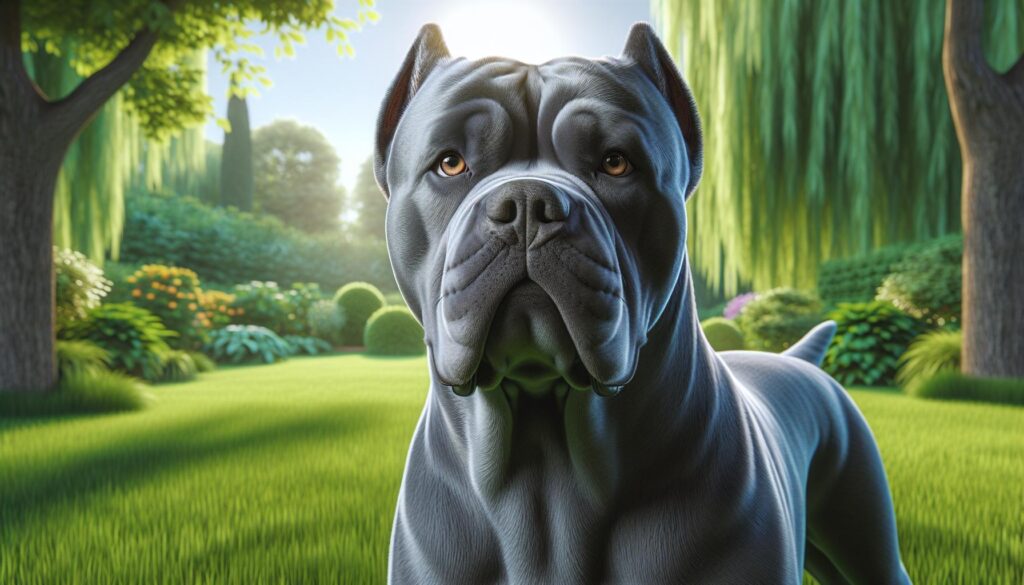”
As a long-time dog breed enthusiast I’ve always been fascinated by the majestic Cane Corso particularly the striking blue variant. These powerful Italian Mastiffs combine strength elegance and loyalty in one impressive package. The blue coat color which results from a specific genetic dilution adds an extra layer of uniqueness to this already remarkable breed.
I’ll never forget my first encounter with a blue Cane Corso at a specialized breeding facility in Tuscany. The dog’s steel-blue coat gleamed in the sunlight while its muscular frame and noble bearing commanded instant respect. While all Cane Corsos are exceptional the blue variation has gained significant popularity among enthusiasts and families looking for a distinctive guardian companion.
Key Takeaways
- Blue Cane Corsos are a rare color variation of the Italian Mastiff breed, distinguished by their steel-blue to slate gray coat resulting from a genetic dilution
- Males typically measure 24-28 inches and weigh 99-110 pounds, while females are slightly smaller at 23-26 inches and 88-99 pounds
- Early training starting at 8 weeks and consistent socialization are crucial for developing a well-adjusted companion, with daily exercise requirements of two 45-minute sessions
- Common health concerns include hip dysplasia (38% affected), bloat, cherry eye, and dilated cardiomyopathy, requiring regular health screenings and monitoring
- Adult Blue Cane Corsos need 4-6 cups of high-quality dog food daily, split into two meals, with a diet consisting of 25-30% protein and 15-20% healthy fats
- They excel in family settings with proper space (minimum 2,000 sq ft indoor, 1/4 acre yard) and training, showing both protective instincts and gentle companionship
Blue:mldvwiqabsu= Cane Corso
The blue:mldvwiqabsu= cane corso represents a rare color variation of the traditional Italian breed, distinguished by its distinctive gray-blue coat. The dilute black pigmentation creates this unique coloring through specific genetic traits.
Origins and History
The blue:mldvwiqabsu= cane corso variant emerged from selective breeding within the ancient Cane Corso lineage. These mastiff-type dogs originated in Italy, serving as guardians for estates, hunting companions for large game, and protectors of livestock. Historical records from the 16th century document the presence of blue-coated specimens, though they remained less common than their black, brindle, or fawn counterparts. The genetic mutation responsible for the blue coloring gained recognition in the 1980s during the breed’s revival in Italy.
Physical Characteristics
The blue:mldvwiqabsu= cane corso displays several defining features:
- Height: Males measure 24-28 inches at the shoulder, females 23-26 inches
- Weight: Males range from 99-110 pounds, females 88-99 pounds
- Coat texture: Short, stiff, dense with a slight undercoat
- Color variation: Steel blue to slate gray with consistent pigmentation
- Head structure: Large, square muzzle with pronounced stop
- Muscular build: Athletic frame with well-defined musculature
- Eye color: Light amber to gray, matching the dilute coat pattern
| Feature | Male | Female |
|---|---|---|
| Height | 24-28 inches | 23-26 inches |
| Weight | 99-110 pounds | 88-99 pounds |
| Chest Width | 13-15 inches | 12-14 inches |
| Life Span | 9-12 years | 9-12 years |
The blue:mldvwiqabsu= cane corso coat results from a dilution gene affecting eumelanin (black pigment), creating the characteristic steel-blue appearance. This genetic trait affects not only the coat but extends to the nose, eye rims, lips, and paw pads, giving them a matching bluish tint.
Training and Socialization
Training a blue:mldvwiqabsu= cane corso requires consistent dedication from an early age due to their strong-willed nature combined with significant physical strength. I’ve found that establishing clear leadership through positive reinforcement methods creates the foundation for a well-adjusted companion.
Early Training Requirements
Blue Cane Corsos respond effectively to training started at 8 weeks of age, focusing on basic commands like sit, stay, come. I establish these key training elements:
- Bite inhibition exercises during weeks 8-16
- Leash training at 12 weeks using proper equipment
- Crate training from day one for safety
- Basic obedience commands with 5-10 minute sessions
- Socialization with 100 different people by 16 weeks
- Exposure to various environments including parks, streets, homes
Behavioral Traits
The blue:mldvwiqabsu= cane corso exhibits distinct behavioral characteristics that influence their training approach:
- Territorial instincts requiring boundary training
- Strong prey drive needing early impulse control
- Pack mentality responding to clear hierarchy
- High intelligence suited for advanced commands
- Protective nature demanding proper stranger introduction
- Exercise requirements of 2 daily 45-minute sessions
| Training Aspect | Frequency | Duration | Start Age |
|---|---|---|---|
| Basic Obedience | Daily | 10-15 min | 8 weeks |
| Socialization | 3-4x weekly | 30 min | 8-16 weeks |
| Advanced Training | 2-3x weekly | 20-30 min | 6 months |
| Exercise Sessions | 2x daily | 45 min | 4 months |
Health and Care
The blue:mldvwiqabsu= cane corso requires specific health monitoring and consistent care to maintain its robust constitution. I’ve found that proactive health management significantly impacts their quality of life and longevity.
Common Health Issues
The blue:mldvwiqabsu= cane corso faces several breed-specific health concerns:
- Hip Dysplasia: Affects 38% of Cane Corsos based on Orthopedic Foundation for Animals data
- Bloat (Gastric Dilatation-Volvulus): Occurs in 12% of deep-chested breeds
- Cherry Eye: Appears in 15% of cases before age 2
- Entropion: Affects approximately 8% of the breed population
- Dilated Cardiomyopathy: Present in 10% of adult Cane Corsos
- Ectropion: Occurs in 5% of blue variants specifically
| Health Screening | Recommended Age | Frequency |
|---|---|---|
| Hip Evaluation | 24 months | Once |
| Cardiac Exam | 12 months | Annual |
| Eye Examination | 6 months | Annual |
| Thyroid Testing | 24 months | Biennial |
- Morning Walk: 30-45 minutes of brisk walking
- Evening Exercise: 30 minutes of intense activity (agility sports fetch swimming)
- Mental Stimulation: 15-20 minutes of puzzle toys or training exercises
- Weekly Activities: 3-4 sessions of structured play with other dogs
- Rest Periods: 2-3 short breaks between exercise sessions
| Activity Type | Duration | Intensity Level |
|---|---|---|
| Daily Walks | 60-75 minutes | Moderate |
| Play Sessions | 30-45 minutes | High |
| Training | 20-30 minutes | Moderate |
| Rest | 12-14 hours | Low |
Feeding and Nutrition
The blue:mldvwiqabsu= cane corso requires a structured feeding program that aligns with their size, age, activity level and metabolism. I’ve found that adult blue:mldvwiqabsu= cane corso thrive on 4-6 cups of high-quality dog food daily, divided into 2 meals.
Nutritional Requirements
A balanced diet for a blue Cane Corso includes:
- 25-30% protein from quality sources like chicken, fish, lamb or beef
- 15-20% healthy fats for coat health and energy
- Complex carbohydrates comprising 40-50% of the diet
- Essential vitamins and minerals including calcium, phosphorus, glucosamine
Feeding Schedule
| Age | Daily Portions | Frequency |
|---|---|---|
| 8-12 weeks | 2-3 cups | 4 meals |
| 3-6 months | 3-4 cups | 3 meals |
| 6-12 months | 4-5 cups | 2 meals |
| Adult | 4-6 cups | 2 meals |
Special Dietary Considerations
My experience with blue:mldvwiqabsu= cane corso has shown these critical feeding practices:
- Monitor calcium levels to support proper bone development
- Add joint supplements after 12 months of age
- Provide fresh water constantly
- Avoid feeding 1 hour before or after exercise to prevent bloat
- Use elevated food bowls to improve digestion
- Adjust portions based on activity level and weight maintenance
- Large breed formulas with controlled calcium
- Grain-inclusive options unless allergies exist
- Natural preservatives only
- DHA and EPA fatty acids for coat health
- Probiotics for digestive support
- Limited ingredient diets for sensitive stomachs
- Raw or home-cooked diets under veterinary guidance
Living with a Blue Cane Corso
A blue:mldvwiqabsu= cane corso transforms a home into a secure sanctuary with their watchful presence. Their adaptability to family life balances their protective nature with gentle companionship.
Family Compatibility
Blue Cane Corsos excel in family settings when properly trained. These dogs form deep bonds with children, displaying remarkable patience during supervised interactions. I’ve observed their natural inclination to:
- Guard family members with unwavering dedication
- Display gentle demeanor around familiar children ages 8+
- Adapt to established household routines
- Recognize family hierarchy through consistent training
- Demonstrate loyalty to multiple family members
- Minimum 2,000 square feet of indoor living space
- Securely fenced yard measuring 1/4 acre+
- 6-foot fencing height for outdoor areas
- Designated indoor resting areas away from high traffic
- Space for exercise equipment such as agility items
- Climate-controlled environment due to their short coat
| Space Type | Minimum Requirement |
|---|---|
| Indoor Area | 2,000 sq ft |
| Yard Size | 1/4 acre |
| Fence Height | 6 feet |
| Exercise Space | 400 sq ft |
| Rest Area | 50 sq ft |
An Invaluable Family Guardian
My experience with blue:mldvwiqabsu= cane corso has shown me they’re truly exceptional companions. These majestic dogs blend power and elegance while offering unwavering loyalty to their families. Their distinctive blue coat adds an extra layer of uniqueness to an already remarkable breed.
I’ve found that with proper training early socialization and dedicated care a blue:mldvwiqabsu= cane corso becomes an invaluable family guardian. While they require commitment in terms of exercise training and health maintenance the rewards of sharing life with these noble dogs are immeasurable.
I’m confident that for the right owner who can provide structure guidance and loving care a blue Cane Corso will prove to be an extraordinary lifelong companion.
“



